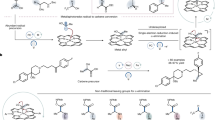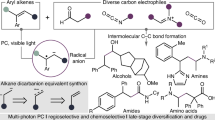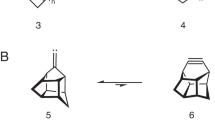Abstract
Carbenes (R1R2C:) like radicals, arynes and nitrenes constitute an important family of neutral, high-energy, reactive intermediates—fleeting chemical entities that undergo rapid reactions. An alkyne (R3C≡CR4) is a fundamental functional group that houses a high degree of potential energy; however, the substantial kinetic stability of alkynes renders them conveniently handleable as shelf-stable chemical commodities. The ability to generate metal-free carbenes directly from alkynes, fuelled by the high potential (that is, thermodynamic) energy of the latter, would constitute a considerable advance. We report here that this can be achieved simply by warming a mixture of a 2-alkynyl iminoheterocycle (a cyclic compound containing a nucleophilic nitrogen atom) with an electrophilic alkyne. We demonstrate considerable generality for the process: many shelf-stable alkyne electrophiles engage many classes of (2-alkynyl)heterocyclic nucleophiles to produce carbene intermediates that immediately undergo many types of transformations to provide facile and practical access to a diverse array of heterocyclic products. Key mechanistic aspects of the reactions are delineated.

This is a preview of subscription content, access via your institution
Access options
Access Nature and 54 other Nature Portfolio journals
Get Nature+, our best-value online-access subscription
27,99 € / 30 days
cancel any time
Subscribe to this journal
Receive 12 print issues and online access
269,00 € per year
only 22,42 € per issue
Buy this article
- Purchase on SpringerLink
- Instant access to full article PDF
Prices may be subject to local taxes which are calculated during checkout






Similar content being viewed by others
Data availability
Preparation procedures and characterization data for all new compounds, computational methodology and data, and copies of all NMR spectra are provided in the PDF of Supplementary Information.
References
Davy, E. Notice of a new gaseous bicarburet of hydrogen. Rep. Sixth Meet. Br. Assoc. Adv. Sci. 5, 62–63 (1836).
Rostovtsev, V. V., Green, L. G., Fokin, V. V. & Sharpless, K. B. A stepwise Huisgen cycloaddition process: copper(I)-catalyzed regioselective ‘ligation’ of azides and terminal alkynes. Angew. Chem. Int. Ed. 41, 2596–2599 (2002).
Tornøe, C. W., Christensen, C. & Meldal, M. Peptidotriazoles on solid phase: [1,2,3]-triazoles by regiospecific copper(i)-catalyzed 1,3-dipolar cycloadditions of terminal alkynes to azides. J. Org. Chem. 67, 3057–3064 (2002).
Hein, J. E. & Fokin, V. V. Copper-catalyzed azide–alkyne cycloaddition (CuAAC) and beyond: new reactivity of copper(i) acetylides. Chem. Soc. Rev. 39, 1302–1315 (2010).
Larock, R. C. & Yum, E. K. Synthesis of indoles via palladium-catalyzed heteroannulation of internal alkynes. J. Am. Chem. Soc. 113, 6689–6690 (1991).
Vicente, R. Recent advances in indole syntheses: new routes for a classic target. Org. Biomol. Chem. 9, 6469–6480 (2011).
Domínguez, G. & Pérez-Castells, J. Recent advances in [2 + 2 + 2] cycloaddition reactions. Chem. Soc. Rev. 40, 3430–3444 (2011).
Shaaban, M. R., El-Sayed, R. & Elwahy, A. H. Construction of fused heterocycles by metal-mediated [2 + 2 + 2] cyclotrimerization of alkynes and/or nitriles. Tetrahedron 67, 6095–6130 (2011).
Pauson, P. L. & Khand, I. U. Uses of cobalt-carbonyl acetylene complexes in organic synthesis. Ann. N. Y. Acad. Sci. 295, 2–14 (1977).
Blanco-Urgoiti, J., Añorbe, L., Pérez-Serrano, L., Domínguez, G. & Pérez-Castells, J. The Pauson–Khand reaction, a powerful synthetic tool for the synthesis of complex molecules. Chem. Soc. Rev. 33, 32–42 (2004).
Ricker, J. D. & Geary, L. M. Recent advances in the Pauson–Khand reaction. Top. Catal. 60, 609–619 (2017).
Bradley, A. Z. & Johnson, R. P. Thermolysis of 1,3,8-nonatriyne: evidence for intramolecular [2 + 4] cycloaromatization to a benzyne intermediate. J. Am. Chem. Soc. 119, 9917–9918 (1997).
Miyawaki, K., Suzuki, R., Kawano, T. & Ueda, I. Cycloaromatization of a non-conjugated polyenyne system: synthesis of 5H-benzo[d]fluoreno[3,2-b]pyrans via diradicals generated from 1-[2-{4-(2-alkoxymethylphenyl)butan-1,3-diynyl}]phenylpentan-2,4-diyn-1-ols and trapping evidence for the 1,2-didehydrobenzene diradical. Tetrahedron Lett. 38, 3943–3946 (1997).
Hoye, T. R., Baire, B., Niu, D., Willoughby, P. H. & Woods, B. P. The hexadehydro-Diels–Alder reaction. Nature 490, 208–212 (2012).
Fluegel, L. L. & Hoye, T. R. Hexadehydro-Diels–Alder reaction: benzyne generation via cycloisomerization of tethered triynes. Chem. Rev. 121, 2413–2444 (2021).
Danheiser, R. L., Gould, A. E., de la Pradilla, R. F. & Helgason, A. L. Intramolecular [4 + 2] cycloaddition reactions of conjugated enynes. J. Org. Chem. 59, 5514–5515 (1994).
Xu, Q. & Hoye, T. R. A distinct mode of strain-driven cyclic allene reactivity: group migration to the central allene carbon atom. J. Am. Chem. Soc. 145, 9867–9875 (2023).
Wang, T., Naredla, R. R., Thompson, S. K. & Hoye, T. R. The pentadehydro-Diels–Alder reaction. Nature 532, 484–488 (2016).
Xu, Q. & Hoye, T. R. Electronic character of α,3-dehydrotoluene intermediates generated from isolable allenyne-containing substrates. Angew. Chem. Int. Ed. 61, e202207510 (2022).
Le, A., Gupta, S., Xu, M., Xia, Y. & Lee, D. Development of an allenyne-alkyne [4 + 2] cycloaddition and its application to total synthesis of selaginpulvilin A. Chem. Eur. J. 28, e202202015 (2022).
Buchner, E. & Feldmann, L. Diazoessigester und toluol. Ber. Dtsch. Chem. Ges. 36, 3509–3517 (1903).
Herzberg, G. & Shoosmith, J. Spectrum and structure of the free methylene radical. Nature 183, 1801–1802 (1959).
Barks, C. The mad chemist. Walt Disney’s Comics and Stories 4, 8 (1944).
Moss, R. A. Carbene chemistry. Chem. Eng. News 47, 60–69 (1969).
Yang, Z., Stivanin, M. L., Jurberg, I. D. & Koenigs, R. M. Visible light-promoted reactions with diazo compounds: a mild and practical strategy towards free carbene intermediates. Chem. Soc. Rev. 49, 6833–6847 (2020).
Das, J. Aliphatic diazirines as photoaffinity probes for proteins: recent developments. Chem. Rev. 111, 4405–4417 (2011).
Davies, H. M. & Manning, J. R. Catalytic C–H functionalization by metal carbenoid and nitrenoid insertion. Nature 451, 417–424 (2008).
Davies, H. M. & Beckwith, R. E. Catalytic enantioselective C−H activation by means of metal−carbenoid-induced C−H insertion. Chem. Rev. 103, 2861–2904 (2003).
von E. Doering, W. & Hoffmann, A. K. The addition of dichlorocarbene to olefins. J. Am. Chem. Soc. 76, 6162–6165 (1954).
Hopkinson, M. N., Richter, C., Schedler, M. & Glorius, F. An overview of N-heterocyclic carbenes. Nature 510, 485–496 (2014).
Breslow, R. & Kim, R. The thiazolium catalyzed benzoin condensation with mild base does not involve a ‘dimer’ intermediate. Tetrahedron Lett. 35, 699–702 (1994).
LeGoff, E. & LaCount, R. B. A thermal tetramer of dimethyl acetylenedicarboxylate. Tetrahedron Lett. 8, 2333–2335 (1967).
Banert, K. et al. Synthesis with perfect atom economy: generation of furan derivatives by 1,3-dipolar cycloaddition of acetylenedicarboxylates at cyclooctynes. Molecules 19, 14022–14035 (2014).
Arora, S., Zhang, J., Pogula, V. & Hoye, T. R. Reactions of thermally generated benzynes with six-membered N-heteroaromatics: pathway and product diversity. Chem. Sci. 10, 9069–9076 (2019).
Nishiwaki, N., Furuta, K., Komatsu, M. & Ohshiro, Y. Novel synthesis of indolizines. J. Chem. Soc. Chem. Commun. 1990, 1151–1152 (1990).
Acheson, R. & Taylor, G. Addition reactions of heterocyclic compounds. Part IV. Dimethyl acetylenedicarboxylate and some pyridines. J. Chem. Soc. 1960, 1691–1701 (1960).
Xia, E.-Y., Sun, J., Yao, R. & Yan, C.-G. Synthesis of zwitterionic salts via three component reactions of nitrogen-containing heterocycles, acetylenedicarboxylate and cyclic 1,3-dicarbonyl compounds. Tetrahedron 66, 3569–3574 (2010).
Swinbourne, F. J., Hunt, J. H. & Klinkert, G. in Advances in Indolizine Chemistry Vol. 23 (eds Katritzky, A. R. & Boulton, A. J.) 103–170 (Academic Press, 1978).
Natural Bond Orbital 7.0 v.7.0.10 (Theoretical Chemistry Institute, University of Wisconsin, Madison, 2018); https://nbo7.chem.wisc.edu/
Wiberg, K. B. Application of the Pople-Santry-Segal CNDO method to the cyclopropylcarbinyl and cyclobutyl cation and to bicyclobutane. Tetrahedron 24, 1083–1096 (1968).
Lauterbach, T. et al. Carbene transfer – a new pathway for propargylic esters in gold catalysis. Adv. Synth. Catal. 355, 2481–2487 (2013).
Hardin, A. R. & Sarpong, R. Electronic effects in the Pt-catalyzed cycloisomerization of propargylic esters: synthesis of 2,3-disubstituted indolizines as a mechanistic probe. Org. Lett. 9, 4547–4550 (2007).
Knezz, S. N., Waltz, T. A., Haenni, B. C., Burrmann, N. J. & McMahon, R. J. Spectroscopy and photochemistry of triplet 1,3-dimethylpropynylidene (MeC3Me). J. Am. Chem. Soc. 138, 12596–12604 (2016).
Reusch, E. et al. Pentadiynylidene and its methyl-substituted derivates: threshold photoelectron spectroscopy of R1-C5-R2 triplet carbon chains. J. Phys. Chem. A 123, 2008–2017 (2019).
Bernhardt, B., Ruth, M., Eckhardt, A. K. & Schreiner, P. R. Ethynylhydroxycarbene (H–C=C–C=–OH). J. Am. Chem. Soc. 143, 3741–3746 (2021).
Padwa, A., Austin, D. J., Gareau, Y., Kassir, J. M. & Xu, S. L. Rearrangement of alkynyl and vinyl carbenoids via the rhodium(II)-catalyzed cyclization reaction of α-diazo ketones. J. Am. Chem. Soc. 115, 2637–2647 (1993).
Casey, C. P., Kraft, S. & Powell, D. R. Formation of cis-enediyne complexes from rhenium alkynylcarbene complexes. J. Am. Chem. Soc. 124, 2584–2594 (2002).
Kim, M., Miller, R. L. & Lee, D. Cross and ring-closing metathesis of 1,3-diynes: metallotropic [1,3]-shift of ruthenium carbenes. J. Am. Chem. Soc. 127, 12818–12819 (2005).
Trost, B. M. The atom economy—a search for synthetic efficiency. Science 254, 1471–1477 (1991).
Acknowledgements
Support for this research came from a grant from the National Science Foundation (NSF, CHE-2155042). A portion of the NMR spectra were obtained with the help of the Shared Instrumentation Grant programme (S10 OD011952) of the National Institutes of Health (NIH). Electrospray ionization high-resolution mass spectrometry data were taken in the Analytical Biochemistry Shared Resource laboratory at the University of Minnesota; a portion of the instrumentation in this Masonic Cancer Center was obtained with the support of the NIH National Cancer Institute (P30 CA077598). DFT computations were carried out using resources provided by the University of Minnesota Supercomputing Institute (MSI).
Author information
Authors and Affiliations
Contributions
Q.X. discovered the first example and performed all of the experimental and computational studies; Q.X. and T.R.H. designed the experiments, interpreted the data and wrote the paper together.
Corresponding author
Ethics declarations
Competing interests
The authors declare no competing interests.
Peer review
Peer review information
Nature Chemistry thanks Bernd Engels and the other, anonymous, reviewer(s) for their contribution to the peer review of this work.
Additional information
Publisher’s note Springer Nature remains neutral with regard to jurisdictional claims in published maps and institutional affiliations.
Supplementary information
Supplementary Information
Supplementary Figs. 1–5, experimental protocols for preparation of all new compounds and full characterization data for their assigned structures, computational results and copies of NMR spectra.
Rights and permissions
Springer Nature or its licensor (e.g. a society or other partner) holds exclusive rights to this article under a publishing agreement with the author(s) or other rightsholder(s); author self-archiving of the accepted manuscript version of this article is solely governed by the terms of such publishing agreement and applicable law.
About this article
Cite this article
Xu, Q., Hoye, T.R. Free carbenes from complementarily paired alkynes. Nat. Chem. 16, 1083–1092 (2024). https://doi.org/10.1038/s41557-024-01550-9
Received:
Accepted:
Published:
Issue Date:
DOI: https://doi.org/10.1038/s41557-024-01550-9
This article is cited by
-
Alkynes fuel free carbene formation
Nature Chemistry (2024)



